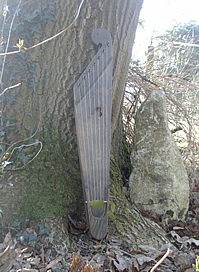

Stringed Instruments
- Alamanic Lyre
- Bowed Lyre ~ Finnish Jouhikko
- Bowed Lyre ~ Shetland Gue
- Baltic Psaltery ~ Finnish Kantele
- Baltic Psaltery ~ Slavic/Russ Gusli
Plucked Lyres
An incredibly ancient family of instruments, dating back to ancient Sumer and beyond. The lyre is still played today, in a plucked form in North Africa, especially in Ethiopia, and in bowed forms as a folk instrument in Wales (Crwth), Estonia (Rootsi-kannel or Hiiu-kannel) and Finland (Jouhikko). There were in the past bowed lyres in Shetland and Norway, I have made an instrument based on the few text descriptions of the Shetland Gue, see below.
The plucked lyre was very widespread in the Ancient world, occupying an important place in Roman and Greek cultures. There are also lyres on Celtic coins and inscriptions, there are several on Pictish stone carvings for example, and it is likely that some of the instrument names in old Irish texts such as Cruit and Tinpan refer to lyres, though they are often translated as 'harp'.
The word 'harp' was likely used for any stringed instrument in Anglo-Saxon (hearpe) and Old Norse (harpa), and 'harpa' still carries that meaning in modern Scandinavian languages.
The Anglo-Saxon lyre found in Sutton-Hoo is justifiably famous, but there are in fact many finds of lyres from Germanic contexts from the first millenium. The best preserved lyres have been found in what was the territory of the Alamanni (what is now Swabia, Bavaria and parts of Switzerland, Austria and France), so it is this instrument I have chosen to reproduce for sale.
|
Alamannic Warrior Lyre. Based on the recent find of a sixth century lyre in a warrior's grave in Trossingen, Germany. This is a practical and surprisingly loud accompanying instrument which can be strummed with a plectrum (blocking the strings one doesn't want to hear in the manner of an Autoharp) or picked harp style. The deep opening for the hands allows both the octave and fifth harmonics to be reached. The Alamanni were a Germanic tribe closely related to Anglo Saxons, and this instrument shows a striking similarity to Anglo Saxon lyres, though is of a plainer and more robust construction as it lacks the weak joint between the top peg holding arm and the body typical of Anglo Saxon lyres. I normally supply these instruments strung with nylgut which sounds close to gut but has the hard wearing and easy-tuning qualities of nylon. Gut is available by special request. |
|
Click on the small image for a bigger picture in a new window. SOUND SAMPLE COMING SOON |
|
|
|
|
|
Bowed Lyres.
The bowed lyres are an ancient family of instruments, which were once widespread all across Europe, but survived into recent times in Europe's cultural fringes, the Baltic, the Scottish Islands and Wales.
There has been much scholarly speculation on their origin. The commonly accepted theory nowadays is that Europeans trading with the Arabs before the year 1000 brought the concept of the musical bow back from its stronghold in the Near East to Europe where it was used to play the six stringed lyre, effectively as a new type of plectrum. It is awkward to play an instrument with six strings and a flat bridge with a bow so the number of strings was reduced . This modified lyre is the ancestor of the diverse bowed lyres known today.
In the early years of the last millenium some lyres were being made with fingerboards and played with a bow. The last member of this latter group survives into modern times in the form of the Crwth. The other bowed lyres have remained without a fingerboard.
|
Bowed Lyre ~ Finnish Jouhikko. The Jouhikko is the name given to a distinctively Finnish type of bowed lyre, though it resembles in some ways types of Baltic Psaltery from further east such as the Slav Gusli, and types of psaltery/lyre hybrids found in the archaeological record from Novgorod, Opole etc. It may be descended from these instruments rather than from the Round Lyre, strictly speaking this would make it a bowed psaltery rather than a bowed lyre, but whether a psaltery with a hand hole should be re-categorised as a lyre is a matter for musicologists... The typical Jouhikko has a long, narrow outline, with only a small hand hole which is offset to one side, allowing only one of the three strings to be stopped. The middle string is a drone, the string furthest from the hand hole is used to play the first note of the scale. I typically build Alto Jouhikkos made to play in the keys of G and A. I sometimes build a smaller 'standard' Jouhikko to play in D. Jouhikkos are usually strung with horsehair, though multi-strand nylon strings are also available. Instruments are supplied without bow, bag and spare strings though these are available as extras. Alto Jouhikkos I made were used in the Lord of the Rings stage show. |
|
|
|
|
|
|
|
|
Bowed Lyre ~ Shetland Gue. It seems that the bowed lyre spread from Scandinavia with Viking colonists, and was taken to the Scottish Islands, many of which were until comparitively recently culturally much more Nordic than Celtic. The bowed lyre survived longest on Shetland, where it was known as late as the 1800s as the Gue. Eventually it was rendered obsolete by the fiddle, and fell out of use. No physical examples survive but written accounts describe it as being played upright between the knees (in the manner of the Baltic Lyres), as having two horse-hair strings, and as being played for weddings and other celebrations. Certain aspects of Shetland fiddle style, such as the use of open tunings, double stopping on the string above as well as below the melody string, and shuffle bowing, may derive from the Gue. It is not known whether this instrument had a fingerboard, but none of the few bowed lyres from Norway or elsewhere in Scandinavia have fingerboards, and as the Shetlands were heavily influenced by Norwegian culture and instrument design it is likely that it also lacked one. I have endeavoured to recreate a two stinged bowed lyre, inspired by Norwegian examples, which may be used by musicians who wish to recreate this lost tradition. It has two horsehair strings and plays in D, G or A depending on the tuning and scale you use. One of my instruments is on display in the Shetland mueum. |
|
|
|
|
|
|
|
Baltic Psalteries
The Finnish Kantele and its relatives (Estonian Kannel, Latvian Kankle, Lithuanian Kokle, Slav Gusli) are ancient members of the zither family. Archeologists have found examples basically identical to modern instruments in deposits dated to around a thousand years ago, though this type of instrument is believed by many experts to be significantly older than that, and may even date back to the Bronze Age. There are written references to the Gusli from the 6th century AD. It may be relat4ed to similar instruments played by other Finno-Ugric peoples such as the Khanty-Mansi instrument known as a Nares-Juh. If this is the case then since these language groups diverged more than 2000 years ago the instrument may be very ancient indeed.
These psalteries have been strung variously with horsehair, gut, sinew or metal. The Novgorod Gusli's were found in association with metal wire, whilst the pegs of some early instruments from elsewhere show little signs of wear, suggesting gut or horsehair was used. Ancient Finnish poetry recounts how the first wooden Kantele was strung with tailhair from the God Hiisi's stallion. Horsehair is the traditional Finnish string material.
I tend to string kantele with steel and guslis with nylgut, though I can use red brass or horsehair on request. The horsehair strung kantele in particular is a very useful instrument with a rich bass tone when played amplified.
|
Baltic Psaltery ~ Kantele Finland and Estonia are close neighbours, with linguistic and cultural links. Their national instruments are similar too, with only minor differences between the Kantele and the Kannel (basically the number of strings, usually 5 in Finland and 6 in Estonia, though more strings is common even in old instruments in both countries). In ancient Finland and Estonia each household had an instrument. The Kantele was believed to have magical properties, and it was played for the ill, for its healing powers. It was said that no-one would die in a house while someone was playing. Before nightfall a Kantele would be carried around the outside of the house, or held up before each door and window , since its very presence was a powerful force against evil. It was considered best to make a new instrument just after the death of a loved one, as something of their soul would come to inhabit it and give it power. The Kantele was also played for dancing, to accompany song, or as a meditation. The songs may have been performed for magical effect, and there is a large body of spell songs preserved in the Finnish Kanteletar. The Kalevala preserves another type of runo-laulu (spell song), that telling of the epic deeds of the Gods and Ancestors. Fortunately many ancient traditional melodies from Finland and the Baltic states were recorded before the tradition of playing was disrupted by the arrival of modernity, the efforts of Puritanical Christianity in Finland and the descent of the Iron Curtain in the Baltic. |
 |
|
|
|
|
|
Baltic Psaltery ~ Gusli The word Gusli is in modern times used by Russians and other Slavic peoples for a range of stringed instruments (rather like the word harpa in Swedish), but we use the word as it is used in the early Bylinys (early Russian literature) to refer to Kantele type instruments, both with and without a playing window. What distinguishes these from true Kantele is the type of string holder, being two seperate pieces attached through or to the soundboard, rather than a single piece that circles round to hold both ends of the string holding rod. The earliest Guslis have playing windows, so one hand can stop the strings sounding whilst the other strums, or so they can be plucked from both sides, like a harp. It is not known whether this type of instrument arose as a response to contact with lyres (and the Gusli previously had no window) or whether they had always had a window. Arguments can be made for both opinions. The earliest Guslis, dating from around 1050, were found in Russ settlements which had a multi-ethnic mix of Finns, Slavs and Scandinavians. The instruments pictured here are based on the Slovisha Gusli, found in Novgorod and dateed to around 1050 AD. It bore the inscription 'Slovisha' (Nightingale) in Cyrillic. These instruments are available strung in red brass, gut or nylgut. |
|
|
|
|
|
|
|
 lyre back.jpg)
 lyre front.jpg)
 lyre pegs.jpg)
 jouhikko package.jpg)
 jouhikko showing pegs.jpg)
 jouhikko back with bow.jpg)
 jouhikko tailpiece and bridge close up.jpg)
 jouhikko in bag.jpg)
 jouhikko front with bow.jpg)
 pair of kantele long shot.jpg)
 pair of kantele back.jpg)
 pair of kantele close up.jpg)
 slovisha_gusli_fronts.jpg)
 slovisha_gusli_backs.jpg)
 slovisha_gusli_heads.jpg)
 slovisha_gusli_pegs.jpg)
 slovisha_gusli_tailpieces.jpg)
 slovisha_gusli_view_down_length.jpg)